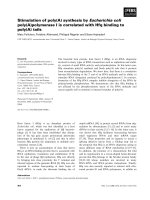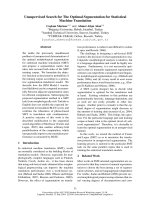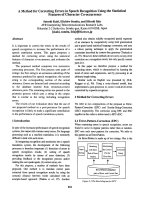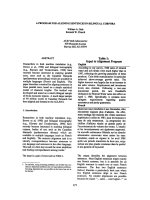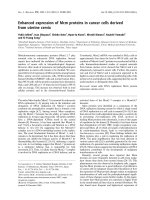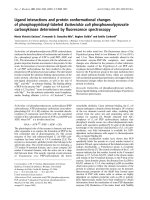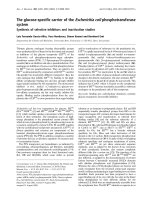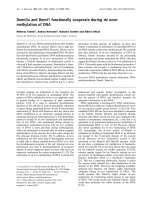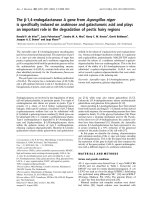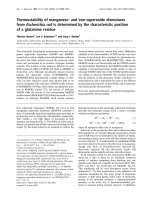Tài liệu Báo cáo Y học: Systematic search for zinc-binding proteins in Escherichia coli potx
Bạn đang xem bản rút gọn của tài liệu. Xem và tải ngay bản đầy đủ của tài liệu tại đây (1.42 MB, 11 trang )
Systematic search for zinc-binding proteins in
Escherichia coli
Akira Katayama
1,2
, Atsuko Tsujii
2
, Akira Wada
3
, Takeshi Nishino
2
and Akira Ishihama
1
National Institute of Genetics, Department of Molecular Genetics, Mishima, Shizuoka, Japan;
2
Nippon Medical School, Department
of Biochemistry and Molecular Biology, Bunkyo-ku, Tokyo, Japan;
3
Osaka Medical School, Department of Physics, Takatsuki,
Osaka, Japan
AsystematicsearchforEscherichia coli proteins with the
zinc-binding activity was performed using the assay of
radioactive Zn(II) binding to total E. coli proteins fraction-
ated by two methods of two-dimensional gel electrophoresis.
A total of 30–40 radioactive spots were identified, of which
14 have been assigned from N-terminal sequencing. In
addition to five known zinc-binding proteins, nine zinc-
binding proteins were newly identified including: acetate
kinase (AckA), DnaK, serine hydroxymethyltransferase
(GlyA), transketolase isozymes (TktA/TktB), translation
elongation factor Ts (Tsf), ribosomal proteins L2 (RplB),
L13 (RplM) and one of S15 (RpsO), S16 (RpsP) or S17
(RpsQ). Together with about 20 known zinc-binding pro-
teins, the total number of zinc-binding proteins in E. coli
increased up to more than 30 species (or more than 3% of
about 1000 proteins expressed under laboratory culture
conditions). The specificity and affinity of zinc-binding were
analysed for some of the zinc-binding proteins.
Keywords: zinc-binding protein; Escherichia coli;proteome;
two-dimensional gel electrophoresis.
Zinc is an essential trace element, but virtually nontoxic, in
contrast to iron, copper and mercury. Over 300 enzymes or
proteins have been identified that require zinc for function
[1,2]. Physical and chemical properties of zinc, such as its
stable association with proteins and its co-ordination
flexibility, make it highly adaptable to meeting the needs
of proteins and enzymes that carry out diverse biological
functions [3]. In zinc-containing enzymes or proteins, zinc
has two major functions, i.e. catalytic and structural. The
catalytic role specifies that zinc participates directly in
enzyme catalysis, while structural zinc atoms are required
for stabilization of proteins by supporting their folding and
oligomerization. Zinc is therefore not simply the cofactor
for enzyme catalytic functions but also the structural factor
for folding of domains involved in protein–protein and
protein–DNA interactions.
A large majority of the zinc-containing enzymes have a
single zinc site consisting of a combination of specific
amino-acid residues such as Cys, His, Asp and Glu, and a
solvent water molecule completing the co-ordination sphere
[3]. After the finding of a number of zinc-containing DNA-
binding proteins in higher eukaryotes, many different types
of the zinc-binding motif have been identified, including
those tetrahedrally co-ordinated to imidazole nitrogen
atoms from His and thiol groups from Cys [2]. The
functions of protein-bound zinc are beginning to catch up
with the increasing number of zinc-containing proteins. Up
to the present time, the structural and functional roles of
zinc have been analysed in detail with zinc-containing
proteins from higher eukaryotes, but little is known about
the zinc-binding proteins in prokaryotes. Ros homologues
that exit in plant-associated agrobacteria are the only
bacterial proteins with the typical C2H2-type zinc-finger
motif [4]. Various types of zinc-containing protein with the
zinc finger or zinc cluster exist in yeast, which, however,
lacks proteins with the hormone receptor-type zinc-binding
motif. This type of zinc-binding proteins appears in
Caenorhabditis elegans [5] and the number of this type of
zinc-binding proteins increases in higher animals.
The aim of this study is to identify as many zinc-binding
proteins as possible in the model prokaryote, Escherichia
coli. For a systematic and experimental detection of zinc-
binding proteins, we employed a conventional method of
radioactive zinc blotting with whole cell extracts fraction-
ated by two methods of two-dimensional gel electrophor-
esis, the widely used O’Farrell system [6] and the newly
developed radical-free and highly reducing (RFHR) method
[7]. Results indicate that most of the newly identified
bacterial zinc-binding proteins do not contain the known
zinc-binding motifs, most of which have been identified in
higher eukaryotes. This report also describes the affinity and
specificity of zinc binding for some of the E. coli zinc-
binding proteins.
MATERIALS AND METHODS
Preparation of cell extracts
E. coli W3110 A-type [8] was grown in Luria–Bertani
medium until late exponential phase (D
600
¼ 0.8 ). Cells
were harvested by centrifugation and cell extracts were
prepared according to Iwakura et al. [9]. In brief, cells were
suspended in lysis buffer (50 m
M
Tris/HCl, pH 8.0 at 4 °C,
1m
M
EDTA) and lysozyme and phenylmethanesulfonyl
fluoride were added to the final concentration of 1 mgÆmL
)1
and 1 m
M
, respectively. After incubation for 10 min at
Correspondence to A. Ishihama, National Institute of Genetics,
Department of Molecular Genetics, Mishima, Shizuoka 411-8540,
Japan. Fax: + 81 559 81 6746, Tel.: + 81 559 81 6741,
E-mail:
Abbreviations: PVDF, poly(vinylidene difluoride); RFHR, radical-free
and highly reducing.
(Received 16 July 2001, revised 28 February 2002,
accepted 22 March 2002)
Eur. J. Biochem. 269, 2403–2413 (2002) Ó FEBS 2002 doi:10.1046/j.1432-1033.2002.02900.x
30 °C, Triton X-100 (Sigma), MgCl
2
and DNase I (Sigma)
were added to the final concentration of 2% (v/v), 10 m
M
and 16.7 UÆmL
)1
, respectively. After removal of insoluble
materials (unlysed cells and cell wall aggregates) by centrif-
ugation at 10 000 g for 10 min at 4 °C, the supernatant
fraction was used as the whole cell extract. The supernatant
fraction was prepared after removal of ribosomes by
centrifugation for 1 h at 100 000 g at 4 °C. Protein
concentration was determined with a Bio-Rad protein assay
kit (Bio-Rad).
Total acid-soluble proteins were prepared from the whole
cell lysate by adding 2 vol. of acetic acid at 4 °C [10]. One
hour after addition of acetic acid, the acid-treated extract
was centrifuged for 10 min at 10 000 g at 4 °Ctoremove
acid-precipitated proteins.
Two dimensional gel electrophoresis
Two methods of two-dimensional gel electrophoresis system
were employed throughout this study. In the O’Farrell
method [6], proteins were separated according to isoelectric
point by isoelectric focusing in the first dimension and then
according to molecular size after denaturation with SDS in
the second dimension. In this series of experiments, we
employed the Pharmacia system and apparatus. In brief, the
18-cm Dry Strips, pH 4–7 (Pharmacia), were rehydrated for
12 h with 0.5 mL of rehydration solution [8
M
urea, 0.5%
(v/v) Triton X-100, 0.075% (w/v) dithiothreitol, 0.5% (v/v)
pH 4–7 IPG buffer (Pharmacia)] containing appropriate
amounts of the whole cell extract or the soluble protein
fraction. First-dimension isoelectric focusing was conducted
for 35 000 Vh using the Multiphor II system (Pharmacia).
The first-dimension Strips were soaked first in 10 mL of
equilibration buffer A [50 m
M
Tris/HCl, pH 6.8 at 4 °C,
30% (v/v) glycerol, 0.5% (w/v) dithiothreitol, 1% (w/v)
SDS, and 6
M
urea] and then in 10 mL of buffer B [50 m
M
Tris/HCl, pH 6.8 at 4 °C, 30% (v/v) glycerol, 4.5%
isoacetamide, 1% (w/v) SDS, and 6
M
urea]. The gels were
then subjected to electrophoresis on the second-dimension
polyacrylamide gel (Excel Gel XL-SDS 12–14).
On the other hand, the RFHR method of two-dimen-
sional gel electrophoresis separates proteins in the presence
of urea but without using SDS and under radical-free and
highly reducing conditions to avoid oxidation of proteins
during electrophoresis [7]. The two-dimensional electro-
phoresis was performed essentially according to the pub-
lished procedure [7] after slight modification as described by
Wada et al. [11] using the modified electrophoresis appar-
atus (Nippon Eido Co., Japan).
Blotting of radioactive zinc
Proteins in the second dimension gels were blotted onto
poly(vinylidene difluoride) (PVDF) membranes (Nippon
Genetics, Japan) using a semidry blotting apparatus (Bio-
Rad). The protein-blotted membranes were subjected to
binding assay of radioactive zinc essentially according to the
method of Mazen et al. [12]. In brief, the protein-blotted
membranes were soaked with buffer A (10 m
M
Tris/HCl,
pH 7.5 at 4 °C) for 1 h at room temperature, and then
incubated in buffer B (10 m
M
Tris/HCl, pH 7.5 at 4 °C,
0.1
M
KCl) containing 0.2 lCiÆmL
)165
ZnCl
2
(specific activ-
ity, 1.84 mCiÆmg
)1
; NEN Life Science Products, Inc.) for
15 min. After washing for 15 min in buffer B, the membranes
were exposed to imaging plates and the plates were analyzed
with a BAS-2000 imaging analyzer (Fuji Film Co., Japan).
Construction of expression plasmids for zinc-binding
proteins
The genes coding for zinc-binding proteins were amplified
by PCR using the whole genome DNA of E. coli W3110 (A)
as template. The forward primers used included the NdeI
site sequence, while the reverse primers included the EcoRI
or BamHI site sequences. The PCR products were directly
inserted between NdeI and either EcoRI or BamHI sites of
an expression vector pGET1 [13]. The reverse primer also
contained the hexahistidine (His) tag sequence; expression
of the target proteins was as fusions with the His tag.
Restriction enzymes used were purchased from Takara
Shuzo, Japan.
Expression and purification of zinc-binding proteins
The expression plasmids for zinc-binding proteins were
transformed into E. coli BL21(DE3) and JM109 (DE3)-
pLysS. The transformed cells were grown in Luria–Bertani
medium containing ampicillin (200 lgÆmL
)1
) and incubated
at 37 °C with shaking. The expression level of zinc-binding
proteins was compared between two recipient strains by
adding 0.5 m
M
isopropyl thio-b-
D
-galactoside. For expres-
sion of Def, DnaJ and RplM, E. coli JM109 transformants
were used for large-scale induction, while AckA, Fur,
MerR, Ppa and RpoA were expressed in E. coli BL21.
For purification of zinc-binding proteins, cells were lysed
in lysis buffer containing 0.2 mgÆmL
)1
lysozyme, 0.2 m
M
phenylmethanesulfonyl fluoride and 1 m
M
dithiothreitol,
followed by sonication. The cell lysates were centrifuged for
2 h at 100 000 g at 4 °C, and the supernatant was directly
subjected to affinity chromatograpy on Ni
2+
-nitrilotriacetic
acid agarose columns (Qiagen) previously equilibrated with
lysis buffer. After washing with lysis buffer containing 3 m
M
imidazole, column-bound proteins were eluted with elution
buffer containing 200 m
M
imidazole. Peak fractions of each
zinc-binding protein were pooled and after dialysis against
storage buffer [10 m
M
Tris/HCl, pH 8.0 at 4 °C, 10 m
M
MgCl
2
,0.1m
M
EDTA, 1 m
M
dithiothreitol, 0.2
M
KCl and
50% (v/v) glycerol], stored at )80 °C until use. Protein
concentration was determined with a Bio-Rad protein assay
kit, while the content of each zinc-binding protein was
measured after separation by SDS/PAGE followed by
staining with Commassie Brilliant Blue R250. The stained
band intensity was measured with LAS-1000 image analyser
(Fuji Film Co., Japan). Sp1 was kindly donated by
Y. Sugiura (Kyoto University, Japan).
RESULTS
Zinc-binding assay of total
E. coli
proteins
fractionated by two dimensional gel electrophoresis
Whole cell extracts (300–400 lg proteins) of exponential-
phase E. coli W3110 type A [8] were separated by two-
dimensional gel electrophoresis by the widely used O’Farrell
method [6]. Proteins in gels were blotted onto PVDF
membranes and then subjected to the binding assay of
2404 A. Katayama et al. (Eur. J. Biochem. 269) Ó FEBS 2002
65
ZnCl
2
. Under the experimental conditions employed,
about 300–400 protein spots were identified after staining
with Coomassie Brilliant Blue (Fig. 1A), of which 20–30
spots were identified to be labelled after exposure to
radioactive Zn(II) (Fig. 1B), suggesting that about 5–10%
protein species have the Zn(II)-binding activity.
The Zn(II)-binding assay was then performed with the
soluble fraction after removal of the group of abundant
proteins such as membrane proteins, ribosomal proteins
and nucleoid-associated DNA-binding proteins (or nucleoid
proteins). The overall pattern of Zn(II) binding was
essentially the same with that obtained using whole cell
extracts (compare Fig. 1B,D). Some Zn(II)-binding spots
detected with the whole cell extracts disappeared, and
instead some new radioactive spots were detected because of
the increase in relative levels for those proteins in the soluble
protein fraction. Because the intensity of Zn(II) binding and
the staining intensity with CBB do not correlate and because
the pattern of radioactive Zn(II) binding differs between
two different preparations of the cell extract, we concluded
that the filter binding assay herein employed allows the
detection of at least a group of proteins with Zn(II)-binding
activity. It should be noted, however, that the intensity of
Zn(II) radioactivity thus detected reflects both the affinity to
Zn(II) and the protein concentration.
To increase in the resolution of basic proteins, we also
employed the RFHR method of two-dimensional gel
electrophoresis [7]. In addition, artefacts arising from
oxidation of proteins during electrophoresis could also be
avoided by using the RFHR method. Figure 2 shows one
example of the Zn(II)-binding assay for acid-soluble basic
proteins separated by the RFHR method. Some of the basic
proteins were newly identified as having Zn(II)-binding
activity. After sequence analysis, these basic proteins were
identified as specific ribosomal proteins (see below). The
ribosomal proteins detected in the region of gel electro-
Fig. 1. Radioactive Zn(II) binding assay of E. coli total proteins fractionated by the O’Farrell method of two-dimensional gel electrophoresis. Awhole
cell extract (A and B, 400 mg) or a soluble protein fraction (C and D, 400 mg) of exponentially growing E. coli W3110 type A were fractionated by
the O’Farrell method [6] of two-dimensional PAGE. After electrophoresis, proteins were blotted onto PVDF membranes followed by staining with
Commassie Brilliant Blue R250 (A and C). The protein-blotted membranes were also subjected to the binding assay of radioactive Zn(II) as
described in Materials and methods (B and D), and then exposed to imaging plates which were analysed with a BAS-2000 image analyser. The
Zn(II)-binding proteins indicated by arrows were analysed for the N-terminal sequences. The spot numbers correspond to the gene numbers listed
in Table 1.
Ó FEBS 2002 Escherichia coli zinc-binding proteins (Eur. J. Biochem. 269) 2405
phoresis exist roughly in stoichiometric amounts, but the
65
Zn radioactivity was detected with only some specific
ribosomal protein spots, supporting the prediction that the
Zn(II)-binding activity detected by the method herein
employed represents specific binding. Taken together we
concluded that a total number of the Zn(II)-binding protein
in E. coli ranges between 20 and 30 proteins among 300–400
major proteins expressed under the culture condition
employed.
Protein sequence analysis for the isolated
Zn(II)-binding proteins
In order to identify the nature of proteins showing Zn(II)-
binding activity, we isolated the major Zn(II)-binding
proteins from PVDF membranes and subjected them to
N-terminal microsequencing. Up to the present time, we
succeeded in identifying the N-terminal sequences for 14
protein spots (Table 1; and also see Figs 1B, 1D and 2B for
the location of these proteins on the two-dimensional gel
patterns), among which four spots included two (AhpC/
Ppa, AtpA/LpdA, and TktA/TktB) or three (RpsO/RpsP/
RpsQ) protein sequences, indicating these two or three
proteins migrated to the same positions on two-dimensional
gel electrophoresis. In the case of AhpC/Ppa spot, Ppa was
identified to be the Zn(II)-binding component, because
the isolated inorganic pyrophosphatase (Ppa) exhibited the
Zn(II)-binding activity (see below), in agreement with the
previous observations [14–16]. Lipoamide dehydrogenase
(LpdA) [17], fructose-1,6-bisphosphatase aldolase (Fba)
[18,19], phosphotransacetylase (Pta) [20] and RNA poly-
merase a subunit (RpoA) [21] have all been shown to
contain or bind zinc in its isolated state. All these
observations indicate that the method employed in this
study is useful for the identification of yet unidentified
Zn(II)-binding proteins. Because the intracellular concen-
trations of Zn(II)-binding proteins thus identified are,
however, different in the cell extracts analysed, the different
intensity of radioactivity for these spots does not necessarily
represent the relative affinity of Zn(II)-binding.
Fig. 2. Radioactive Zn(II) binding assay of E. coli acid-soluble proteins fractionated by the RFHR method of two-dimensional gel electrophoresis.
Acid-soluble proteins (380 mg), prepared from the whole cell lysate of exponentially growing E. coli W3110 type-A, were fractionated by the
RFHR method [7] of two-dimensional PAGE. After electrophoresis, proteins were blotted onto PVDF membranes followed by staining with
Commassie Brilliant Blue R250 (A). The locations of low-molecular-mass ribosomal proteins are indicated. The protein-blotted membrane was also
subjected to the binding assay of radioactive Zn(II) as described in Materials and methods (B), followed by exposure to an imaging plate, which was
then analysed with a BAS-2000 image analyser (Fuji, Japan). The Zn(II)-binding proteins indicated by arrows were analysed for the N-terminal
sequences. The spot numbers correspond to the gene numbers listed in Table 1.
Table 1. Zinc binding proteins. Protein spots with zinc-binding activity
were cut out from PVDF membranes and immediately subjected to
N-terminal microsequencing. From the sequence results, the genes
coding for these proteins were identified. Protein spots, AhpC/Ppa,
AtpA/LpdA, RpsO/RpsP/RpsQ and TktA/Tkt, were found to contain
multiple proteins, among which Ppa and LpdA were identified to have
the zinc-binding activity. Asterisks indicate the previouslyidentified
zinc-containing proteins in E. coli (see Table 2).
Spot Gene product Function
1 AckA Acetate kinase
2 DnaK Hsp70 chaperone
3 Fba* Fructose 1,6-bisphosphatase
aldolase
4 GlyA Serine hydroxymethyltransferase
5 LpdA* (AtpA) Lipoamide dehydrogenase
(F1 ATP synthase a subunit)
6 Ppa* (AhpC) Inorganic pyrophosphatase
(alkyl hydroperoxide reductase C22)
7 Pta* Phosphotransacetylase
8 RpoA* RNA polymerase a subunit
9 RplB 50S ribosomal protein L2
10 RplM 50S ribosomal protein L13
11 RpsB 30S ribosomal protein S2
12 RpsO/RpsP/RpsQ 30S ribosomal protein S15, S16 or
S17
13 TktA/TktB Transketolase isozymes
14 Tsf Translation elongation factor Ts
2406 A. Katayama et al. (Eur. J. Biochem. 269) Ó FEBS 2002
Confirmation of the Zn(II)-binding activity
using purified proteins
To confirm the Zn(II)-binding activity and to estimate the
Zn(II)-binding affinity for the newly identified Zn(II)-
binding proteins, we next cloned the genes encoding some
of the newly identified Zn(II)-binding proteins into expres-
sion vectors, over-expressed His
6
-tagged proteins in trans-
formed E. coli cells, and affinity-purified the His
6
-tagged
proteins to apparent homogeneity. Equal amounts of the
purified Zn(II)-binding proteins were subjected to the
Zn(II)-binding assay. Figure 3 shows the
65
Zn(II)-binding
activity for two proteins, RplM (ribosomal protein L13) and
RpoA (RNA polymerase a subunit), in parallel with four
known heavy metal-binding proteins, Zn(II)-binding Def
(peptide deformylase) [22,23], Hg(II)-binding MerR (mer-
cury export regulation protein) with Zn(II)-binding activity
[24,25] and Fe(II)-binding Zn(II)-containing Fur (ferric
uptake regulation protein) [26,27] and Zn(II)-binding BSA
(bovine serum albumin) [28], and one control protein,
RpoD (RNA polymerase r subunit) with no known activity
of Zn(II)-binding.
65
Zn(II) binding was detected even at low
protein concentrations for Def, MerR, Fur and RpoA
(Fig. 3C), and in addition, for RplM and BSA at high
protein concentrations (Fig. 3D). In addition to RplM and
RpoA, Zn(II)-binding activity was confirmed for other
three purified proteins, AckA (acetate kinase), Ppa (inor-
ganic pyrophosphatase) and DnaJ (see below). Here we
detected a low level of Zn(II) binding for RpoD, the RNA
polymerase r
70
subunit (see also below). At present,
however, it is not clear whether this represents a background
activity of nonspecific Zn(II) binding or RpoD carries a
weak but specific Zn(II)-binding site.
The test proteins were isolated as fusion forms with His
6
-
tag added at the C-terminus. The possible influence of the
His
6
tag on the Zn(II)-binding activity was then tested. The
His
6
tag added to the test proteins was found to show a low
level of the Zn(II)-binding activity, but the level of
65
Zn(II)-
blotting by the His
6
tag was less than 25%, if any, of the
total Zn(II)-binding activity by the Zn(II)-binding proteins
examined (for examles see AckA, RpoA and Ppa, shown in
Figs 6A and 8). To confirm this prediction, the Zn(II)
binding assay was also performed for untagged proteins (see
below).
Fig. 3. Radioactive Zn(II)-binding assay of purified E. coli proteins. The newly identified Zn(II)-binding proteins, RplM (L13) and RpoA (RNA
polymerase a subunit), and the previously identified Zn(II)-binding proteins, Def, MerR and Fur, were purified from over-expressed E. coli cells.
Equal amounts (A and C, 20 pmol each; and B and D, 100 pmol each) of the purified proteins were analysed, together with whole cell lysate (A and
C, 1 lg; B and D, 5 lg), BSA (A and C, 1 lg; B and D, 5 lg), RNA polymerase (A and C, 1 lg; B and D, 5 lg) and RpoD (RNA polymerase r
subunit) (A and C, 1 lg; B and D, 5 lg), by SDS/PAGE. After electrophoresis, the proteins were blotted onto PVDF membranes followed by
staining with Commassie Brilliant Blue R250 (A and B). The protein-blotted membranes were also subjected to the binding assay of radioactive
Zn(II) as described in Materials and methods (C and D), followed by exposure to an imaging plate which was analysed with a BAS-2000 image
analyser. CH represents the hexahistidine (His) tag added at the C-terminus of each protein. RPase core indicates the RNA polymerase core enzyme
with the subunit composition a
2
bb¢.
Ó FEBS 2002 Escherichia coli zinc-binding proteins (Eur. J. Biochem. 269) 2407
Affinity of Zn(II) binding by the purified Zn(II)-binding
proteins
Using the purified proteins, we then measured the Zn(II)-
binding affinity. For this purpose, the level of protein-bound
65
Zn(II) was measured using the same amounts of the newly
identified Zn(II)-binding proteins, AckA and Ppa, and the
known metal-binding proteins, Def, MerR and Fur, in the
presence of a fixed amount of radioactive Zn(II) and
increasing concentrations of nonradioactive Zn(II). The
level of Zn(II) binding to all the test proteins increased
concomitantly with the increase of Zn(II) concentration
[note the decrease in specific radioactivity of
65
Zn(II)]
(Fig. 4). The affinity of Zn(II) binding by both AckA and
Ppa was estimated to be within the same range of those of
the reference proteins, Def, MerR and Fur.
Specificity of Zn(II) binding by the whole cell extracts
To examine the specificity of Zn(II) binding for the known
and novel E. coli Zn(II)-binding proteins, we performed the
competitive inhibition assay of
65
Zn(II) binding with other
metals. The pattern of radioactive Zn(II) binding by the
whole cell extract (Fig. 5B) was essentially the same with
that observed in Fig. 1. By the addition of 100 l
M
nonradioactive Zn(II), the concentration giving more than
90% inhibition (see Fig. 4), the level of radioactive Zn(II)
binding decreased to below 10% (Fig. 5C). The level of
radioactive Zn(II) binding, however, remained essentially at
the same levels by the addition of 100 l
M
Mg(II) (Fig. 5D),
Ni(II) (Fig. 5E) and Cd(II) (Fig. 5F). The results indicate
that the activity of Zn(II) binding detected by the conven-
tional filter binding assay of radioactive Zn(II) represents
the specific binding activity to Zn(II), but is not attributable
to nonspecific metal binding.
Specificity of Zn(II) binding by the purified
Zn(II)-binding proteins
The specificity of Zn(II) binding was also examined for the
purified Zn(II)-binding proteins. The binding of radioactive
Zn(II) to AckA, Def, DnaJ, Fur, MerR, Ppa, RplM, and
RpoA was tested in the presence of 100 l
M
nonradioactive
ZnCl
2
,MgCl
2
or FeCl
3
. The amount of radioactive Zn(II)
binding decreased by the addition of nonradioactive Zn(II)
(Fig. 6B) and the reduction level was apparently the same
between the test proteins. In contrast, the Zn(II) binding
activity by these proteins was not affected by the addition of
Mg(II) (Fig. 6C) and Fe(III) (Fig. 6D). Although the Fur
protein has a high affinity to Fe(III), the binding of
radioactive Zn(II) to Fur was not interfered with the
addition of Fe(III) (Fig. 6D), being consistent with the
finding that the site of zinc binding is different from the iron-
binding site [27].
The Zn(II) binding activity of AckA, Def, DnaJ, Fur,
MerR, Ppa, and RplM was also tested in the presence of
Ca(II), Cu(II) and Cd(II) (Fig. 7), but none of these metals
affected the binding of radioactive Zn(II) to the test
proteins. Taken the results of all these competition assays
together we concluded that the observed Zn(II)-binding
activity by the test proteins represents the specific binding of
Zn(II).
Fig. 4. Dose-dependent binding of Zn(II) to purified E. coli zinc-binding proteins. The newly identified E. coli Zn(II)-binding proteins, AckA and
Ppa, were analysed, together with the known Zn(II)-binding proteins, Def, MerR, Fur and Sp1, for radioactive Zn(II) binding in the presence of
indicated concentrations of nonradioactive ZnCl
2
. Proteins analysed were: lane 1, AckA(CH) + Ppa(CH) + MerR(CH) + Sp1; and lane 2,
Def(CH) + Fur(CH). After electrophoresis, the proteins were blotted onto PVDF membranes and the protein-blotted membranes were subjected
to the binding assay of
65
ZnCl
2
(0.2 lCiÆmL
)1
) in the presence of indicated concentrations of nonradioactive ZnCl
2
, followed by exposure to
imaging plates which were then analysed with a BAS-2000 image analyser.
2408 A. Katayama et al. (Eur. J. Biochem. 269) Ó FEBS 2002
To exclude the influence of His-tag on the activity and
specificity of Zn(II) binding, we checked the specificity of
Zn(II) binding using purified proteins without the His-tag.
The Zn(II)-binding specificity was examined for untagged
EF-Tu (Tuf), EF-Ts (Tsf), RpoA, Ppa and Sp1. The
radioactive Zn(II) binding was competed by nonradioactive
Zn(II) but not by Ca(II), Cd(II), Mg(II) and Ni(II)
(Fig. 8A,B). Again a low level of Zn(II)-binding activity
was detected for RpoD when analysed using a large amount
of protein. Taken together we conclude that the activity of
Zn(II) binding herein detected is not due to the His
6
tag but
the E. coli proteins (and Sp1) and that the binding is specific
to Zn(II) and does not occur for other divalent metals.
DISCUSSION
Physiological roles of the protein-bound zinc in enzyme
catalytic functions and formation of protein functional
domains, in particular those involved in protein–protein and
protein–nucleic acid interactions, have been studied in
Fig. 5. Competition of radioactive Zn(II) binding to E. coli proteins by nonradioactive metals. About 400 mg of the soluble fraction of whole cell
extract of exponentially growing E. coli W3110 type A [8] was fractionated by the O’Farrell method [6] of two-dimensional PAGE. After
electrophoresis, proteins were blotted onto PVDF membranes followed by staining with Commassie Brilliant Blue R250 (A). The protein-blotted
membranes were also subjected to the binding assay of radioactive Zn(II) as described in Fig. 1B in the absence (B) or presence of 100 l
M
ZnCl
2
(C), MgCl
2
(D), NiCl
2
(E) or CdCl
2
(F). The filters were treated as described in Fig. 4.
Fig. 6. Competition of radioactive Zn(II) binding by nonradioactive metals, Zn(II), Mg(II) and Fe(III), to purified E. coli zinc-binding proteins.
Mixtures of the purified Zn(II)-binding proteins were subjected to radioactive Zn(II)-binding assay in the absence (A) or presence of 100 l
M
nonradioactive Mg(II) (B), Zn(II) (C) or Fe(III) (D). Proteins analysed were: Lane 1, AckA; lane 2, AckA(CH) + Ppa(CH) + Sp1; lane 3, Ppa;
lane 4, RpoA(CH) + RplM(CH); lane 5, RpoA + MerR(CH); lane 6, Fur(CH); lane 7, Def(CH); lane 8, DnaJ(CH). After SDS/PAGE, gels were
treated as described in Fig. 4.
Ó FEBS 2002 Escherichia coli zinc-binding proteins (Eur. J. Biochem. 269) 2409
details for zinc-containing metalloproteins from higher
animals (reviewed in [3]). In contrast, relatively little is
known about the roles of zinc in function and structure of
proteins from prokaryotes. The total number of known
zinc-containing E. coli protein species that have been
experimentally examined to date is not more than 20
(Table 2). Here we performed, for the first time in E. coli
molecular genetics, a systematic search for E. coli proteins
Fig. 7. Competition of radioactive Zn(II) binding to purified E. coli zinc-binding proteins by nonradioactive metals, Ca(II), Cu(II) and Cd(II). Mixtures
of the purified Zn(II)-binding proteins (100 pmol each) were subjected to the Zn(II)-binding assay (
65
ZnCl
2
,0.2lCiÆmL
)1
)intheabsenceor
presence of 100 l
M
nonradioactive Zn(II), Ca(II), Cu(II) or Cd(II). Proteins analysed were: lane 1, DnaJ(CH) + Sp1; lane 2, MerR(CH); lane 3,
RpoA + Def(CH) + Fur(CH); and lane 4, AckA(CH) + Ppa(CH) + RplM(CH). After SDS/PAGE, gels were treated as described in Fig. 4.
Fig. 8. Competition of radioactive Zn(II) binding to purified zing-binding proteins without His-tag by nonradioactive metals. Purified zinc-binding
proteins without His-tag were analysed for radioactive Zn(II) binding in the presence or absence of nonradioactive metals as indicated on bottom of
each gel lane. (A) Lane 1, EF-Tu + EF-Ts; lane 2, RpoD + RpoA; lane 3, AckA + Ppa + Sp1. (B) Lanes 1–6, AckA + Ppa.
2410 A. Katayama et al. (Eur. J. Biochem. 269) Ó FEBS 2002
with the Zn(II)-binding activity, by using the conventional
radioactive Zn(II)-binding assay onto filter-bound proteins
after separation of total proteins by two-dimensional gel
electrophoresis. About 20–30 proteins have been identified
to have the binding activity of
65
Zn(II) (see Figs 1 and 2).
After N-terminal sequencing, the nature of proteins has
been identified for 14 species, including five known zinc-
containing proteins, Fba (fructose-1,6-bisphosphatase aldo-
lase), LpdA (lipoamide dehydrogenase), Ppa (inroganic
pyrophosphatase), Pta (phosphotransacetylase) and RpoA
(RNA polymerase a subunit) (compare Tables 1 and 2).
Because the level of radioactive Zn(II) association did not
correlate with the amount of protein, the Zn(II) binding
capability detected by the method herein employed was
considered to represent the intrinsic activity of Zn(II)
binding. Thus the Zn(II)-binding proteins herewith identi-
fied may require Zn(II) as an intrinsic cofactor for either the
formation of native conformations or the expression of their
intrinsic functions.
The success of detection of specific Zn(II)-binding
proteins agrees with the prediction that the formation of
Zn(II)-binding site includes short stretches of the protein
sequence that can be easily refolded after denaturation
during electrophoretic separation of proteins. The E. coli
proteins detected in this study must belong to a group of
proteins with similar affinity to Zn(II). In fact, the binding
affinity of Zn(II) as measured by competition assay (see
Fig. 4) was similar between this group of proteins. Conse-
quently It can not be excluded that Zn(II)-binding motifs,
which require longer stretches of the protein and can not be
refolded after one cycle of denaturation-renaturation treat-
ment, could not be detected by the method herein employed.
Under laboratory culture conditions, E. coli expresses at
most 1000 genes out of 4000 ORFs on the genome, as
detected by two-dimensional gel electrophoresis. In this
study, we identified 20–30 Zn(II)-binding proteins among
300–400 E. coli proteins (or 5–10% of total open reading
frames). If the relative amount of Zn(II)-binding proteins in
terms of total protein species is the same for other E. coli
proteins, the total number of zinc-binding proteins in E. coli
could be about 200–400 (or 5–10% of a total of 4000 open
reading frames on the E. coli genome). Most of the Zn(II)-
binding proteins herein detected do not contain any of
the known zinc-binding motifs, which were identified in
zinc-containing proteins from higher eukaryotes. After a
computational search for Zn(II)-binding E. coli proteins,
however, we identified only a total of about 30 proteins
(N. Fujita & A. Ishihama, unpublished results). These
findings suggest that most of the E. coli Zn(II)-binding
proteins is composed of unidentified Zn(II)-binding motifs
that are different from the known eukaryote-type Zn(II)-
binding motifs.
In addition to the known zinc-containing proteins, we
obtained in this study experimental evidence showing Zn(II)
binding for some E. coli proteins, including acetate kinase
(AckA) that is known to require the metal for expression of
the catalytic function [29], DnaK that is considered to carry
zinc as in the case of DnaJ [30,31], and serine hydroxymeth-
yltransferase (GlyA), which requires a metal as a cofactor for
its enzyme function. Previously, none of the ribosomal
proteins in E. coli have been identified as having binding
activity for Zn(II). Here we identified for the first time that
Zn(II) can bind to at least four ribosomal proteins, L2
(RplB), L13 (RplM), S2 (RpsB) and one (or two) of S15
(RpsO), S16 (RpsP) or S17 (RpsQ). The possible involve-
ment of zinc in either the assembly of these ribosomal
proteins into ribosomes or the expression of intrinsic
functions of these ribosomal proteins is to be examined.
The secX gene product of E. coli is now recognized as the
smallest subunit L36 of 50S large ribosomal subparticle [32].
From the solution structure by NMR, the 37-amino-acid
Thermus thermophilus L36 protein was found to contain zinc
at a zinc-ribbon-like fold [33] even though the function of
L36 is yet unidentified. The pattern of three Cys residues and
a following His residue in the bacterial L36 protein, however,
does not match that of any other known zinc-finger protein.
In the two-dimensional gel electrophoresis conditions
employed (Fig. 2), however, L36 migrated outside the gel
space that was subjected to Zn(II)-binding assay.
ACKNOWLEDGEMENTS
We thank Katsunori Yata (National Institute of Genetics, RI Centre)
for expression and purification of Fur and MerR proteins, and Yukio
Sugiura (Kyoto University) for the gift of Sp1. This work was
supported by Grants-in-Aid from the Ministry of Education, Science,
Culture and Sports of Japan, and by CREST fund from the Japan
Science Corporation (JSP).
REFERENCES
1. Vallee, B.L. & Auld, D.S. (1990) Zinc coordination, function, and
structure of zinc enzymes and other proteins. Biochemistry 29,
5647–5659.
2. Coleman, J.E. (1992) Zinc proteins: enzymes, storage proteins,
transcription factors, and replication proteins. Annu. Rev. Bio-
chem. 61, 897–946.
3. Vallee, B.L. & Falchuk, K.H. (1993) The biochemical basis of zinc
physiology. Physiol. Rev. 73, 79–118.
4. Bouhouche, N., Syvanen, M. & Kado, C.I. (2000) The origin
of prokaryotic C2H2 zinc finger regulators. Trends Microbiol. 8,
77–81.
Table 2. Zinc-binding proteins in Escherichia coli.
Protein Function Reference
Ada Transcription factor for ada operon [34]
Cdd Cytidine deaminase [35]
Def Peptide deformylase (PDF) [22]
DnaG Primase for DNA replication [36]
DnaJ Molecular chaperone [30]
Fba Fructose 1,6-bisphosphatase [18]
Fpg Formamidepyrimidine-DNA glycosylase [37]
FtsH ATP-dependent protease [38]
Fur Ferric uptake regulaiton protein [26]
HemB 5-Aminolevulinic acid dehydratase [39]
LpdA Lipoamide dehydrogenase [17]
MetE Cobalamin-indepd. methionine synthase [40]
MetH Cobalamin-depd. methionine synthase [41]
PhoA Alkaline phosphatase [42]
Ppa Inorganic pyrophosphatase [12]
Pta Phosphotransacetylase [20]
RpoA RNA polymerase a subunit [21]
RpoC RNA polymerase bı
´
subunit [43]
RpoB RNA polymerase b subunit [44]
UvrA Repair enzyme ABC nuclease [45]
Ó FEBS 2002 Escherichia coli zinc-binding proteins (Eur. J. Biochem. 269) 2411
5. Clarke, N.D. & Berg, J.M. (1998) Zinc fingers in Caenorhabditis
elegans: finding families and probing pathways. Science 282, 2018–
2022.
6. O’Farrell, P.H. (1975) High resolution two-dimensional gel elec-
trophoresis of proteins. J. Biol. Chem. 250, 4007–4021.
7. Wada, A. (1986) Analysis of Escherichia coli ribosomal proteins by
an improved two dimensional gel electrophoresis. I. Detection of
four new proteins. J. Biochem. 100, 1583–1594.
8. Jishage, M. & Ishihama, A. (1997) Variation in RNA polymerase
sigma subunit composition within different stocks of Escherichia
coli strain W3110. J. Bacteriol. 179, 959–963.
9. Iwakura, Y., Ito, K. & Ishihama, A. (1974) Biosynthesis of RNA
polymerase in Escherichia coli,I.ControlofRNApolymerase
content at various growth rates. Mol. Gen. Genet. 142, 1–23.
10. Hardy, S.J., Kurland, C.G., Voynow, P. & Mora, G. (1969) The
ribosomal proteins of Escherichia coli, I. Purification of the 30S
ribosomal proteins. Biochemistry 8, 2897–2905.
11. Wada, A., Yamazaki, Y., Fujita, N. & Ishihama, A. (1990)
Structure and probable genetic location of a Ôribosome modu-
lation factorÕ associated with 100S ribosomes in the stationary-
phase Escherichia coli cells. Proc.NatlAcad.Sci.USA87,
2657–2661.
12. Mazen, A., Grandwohl, G. & de Murcia, G. (1988) Zinc-binding
proteins detected by protein labeling. Anal. Biochem. 172, 39–42.
13. Katayama, A., Fujita, N. & Ishihama, A. (2000) Mapping of
subunit-subunit contact surfaces on the b¢ subunit of Escherichia
coli RNA polymerase. J. Biol. Chem. 275, 3583–3592.
14. Avaeva, S.M., Ignatov, P., Kurilova, S., Nazarova, T., Rodina, E.,
Vorobyeva, N., Oganessyan, V. & Harutyunyan, E. (1996)
Escherichia coli inorganic pyrophosphatase: site-directed muta-
genesis of the metal binding sites. FEBS Lett. 399, 99–102.
15. Efimova, I.S., Salminen, A., Pohjanjoki, P., Lapinniemi, J.,
Magretova,N.N.,Cooperman,B.S.,Goldman,A.,Lahti,R.&
Baykov, A.A. (1999) Directed mutagenesis studies of the metal
binding site at the subunit interface of Escherichia coli inorganic
pyrophosphatase. J. Biol. Chem. 274, 3294–3299.
16. Kankare, J., Salminen, T., Lahti, R., Cooperman, B.S., Baykov,
A.A. & Goldman, A. (1996) Crystallographic identification of
metal-binding sites in Escherichia coli inorganic pyrophosphatase.
Biochemistry 35, 4670–4677.
17. Olsson, J.M., Xia, L., Eriksson, L.C. & Bjornstedt, M. (1999)
Ubiquinone is reduced by liposamide dehydrogenase and
this reaction is potently stimutaled by zinc. FEBS Lett. 448,
190–192.
18. Berry, A. & Marshall, K.E. (1993) Identification of zinc-binding
ligands in the class II fructose-1,6-bisphosphate aldolase of
Escherichia coli. FEBS Lett. 318, 11–16.
19. Cooper, S.J., Leonard, G.A., McSweeney, S.M., Thompson,
A.W.,Naismith,J.H.,Qamar,S.,Plater,A.,Berry,A.&Hunter,
W.N. (1996) The crystal structure of a class II furctose-1,6-
bisphosphate aldolase shows a novel binuclear metal-binding
active site embedded in a familiar fold. Structure 4, 1303–1315.
20. Matsuyama, A., Yamamoto-Otake, H., Hiwitt, J., MacGillivray,
R.T. & Nakano, E. (1994) Nucleotide sequence of the phospho-
transacetylase gene of Escherichia coli strain K12. Biochim. Bio-
phys. Acta 1219, 559–562.
21. Sujatha, S. & Chatterji, D. (1999) Detection of putative Zn (II)
binding sites within Escherichia coli RNA polymerase: incon-
sistency between sequence-based prediction and
65
Zn blotting.
FEBS Lett. 454, 169–171.
22. Meinnel, T. & Blanquet, S. (1993) Evidence that peptide
deformylase and methionyl-tRNA (fMet) formyltransferase are
encoded within the same operon in Escherichia coli. J. Bacteriol.
175, 7737–7740.
23. Meinnel, T., Blanquet, S. & Dardel, F. (1996) A new subclass of
the zinc metalloproteases superfamily revealed by the solution
structure of peptide deformylase. J. Mol. Biol. 262, 375–386.
24. Caguiat, J.J., Watson, A.L. & Summers, A.O. (1999) Cd(II)-
responsive and constitutive mutants implicate a novel domain in
MerR. J. Bacteriol. 181, 3462–3471.
25. Bontidean, I., Lloyd, J.R., Hobman, J.L., Wilson, J.R., Csoregi,
E., Mattiasson, B. & Grown, N.L. (2000) Bacterial metal-
resistance proteins and their use in biosensers for the detection of
bioavailable heavy metals. J. Inorg. Biochem. 79, 225–229.
26. Althaus,E.W.,Outten,C.E.,Olson,K.E.,Cao,H.&Oı
´
Halloran,
T.V. (1999) The ferric uptake regulation (Fur) repressor is a zinc
metalloprotein. Biochemistry 38, 6559–6569.
27. Gonzalez de Peredo, A., Saint-Pierre, C., Adrait, A., Lacquamet,
L., Latour, J.M., Michaud-Soret, I. & Forest, E. (1999) Identifi-
cation of the two zinc-bound cysteines in the ferric uptake reg-
ulation protein from Escherichia coli: chemical modification and
mass spectrometry analysis. Biochemistry 38, 8582–8589.
28. Ohyoshi, K., Hamada, Y., Nakata, K. & Kohata, S. (1999) The
interaction between human and bovine serum albumin and zinc
studied by a competitive spectrophotometry. Inorg. Biochem. 75,
213–218.
29. Singh-Wissmann, K., Ingram-Smith, C., Miles, R.D. & Ferry,
J.G. (1998) Identification of essential glutamates in the acetate
kinase from Methanosarcina thermophila. J. Bacteriol. 180, 1129–
1134.
30. Banecki,B.,Liberek,K.,Wall,D.,Wawrzynow,A.,Georgopo-
ulos,C.,Bertoli,E.,Tanfani,F.&Zylicz,M.(1996)Structure–
function analysis of the zinc finger region of the DnaJ molecular
chaperone. J. Biol. Chem. 271, 14840–14848.
31. Martinez-Yamout,M.,Legge,G.B.,Zhang,O.,Wright,P.E.&
Dyson, H.J. (2000) Solution structure of the cysteine-rich domain
of the Escherichia coli chaperone protein DnaJ. J. Mol. Biol. 300,
805–818.
32. Wada, A. & Sako, T. (1987) Primary structures of and genes for
new ribosomal proteins A and B in Escherichia coli. J. Biochem.
101, 817–820.
33. Hard, T., Rak, A., Allard, P., Kloo, L. & Garber, M. (2000) The
solution structure of ribosomal protein L36 from Thermus thermo-
philus reveals a zinc-ribbon-like fold. J. Mol. Biol. 296, 189–180.
34. Myers, L.C., Terranova, M.P., Nash, H.M., Markus, M.A. &
Verdine, G.L. (1992) Zinc binding by the methylation signaling
domain of the Escherichia coli Ada protein. Biochemistry 31, 4541–
4547.
35. Betts,L.,Xiang,S.,Short,S.A.,Wolfenden,R.&Carter,C.S.
(1994) Cytidine deaminase, the 2.3 A
˚
crystal structure of an
enzyme: transition-state analog complex. J. Mol. Biol. 235,635–
656.
36. Stamford, N.P., Lilley, P.E. & Dixon, N.E. (1992) Enriched
sources of Escherichia coli replication proteins. The dnaG primase
is a zinc metalloprotein. Biochim. Biophys. Acta 1132, 17–25.
37. Oı
´
Connor, T.R., Graves, R.J., de Murcia, G., Castaing, B. &
Laval, J. (1993) Fpg protein of Escherichia coli is a zinc finger
protein whose cysteine residues have a structural and/or functional
role. J. Biol. Chem. 268, 9063–9070.
38. Tomoyasu, T., Gamer, J., Bukau, B., Kanemori, M., Mori, H.,
Rutman,A.J.,Oppenheim,A.B.,Yura,T.,Yamanka,K.,Niki,
H. & Ogura, T. (1995) Escherichia coli FtsH is a membrane-
bound, ATP-dependent protease which degrades the heat-shock
transcription factor sigma 32. EMBO J. 14, 2551–2560.
39. Erskine,P.T.,Norton,E.,Cooper,J.B.,Lambert,R.,Coker,A.,
Lewis, G., Spencer, P., Sarwar, M., Wood, S.P., Warren, M.J. &
Shoolingin-Jordan. (1999) X-ray structure of 5-aminolevuinic
acid dehydratase from Escherichia coli complexed with the inhi-
bitor levulinic acid at 2.0 A
˚
resolution. Biochemistry 38,
4266–4276.
40. Gonzalez,J.C.,Peariso,K.,Penner-Hahn,J.E.&Matthews,R.G.
(1996) Cobalamin-independent methionine synthase from
Escherichia coli: a zinc metalloenzyme. Biochemistry 35, 12228–
12234.
2412 A. Katayama et al. (Eur. J. Biochem. 269) Ó FEBS 2002
41. Goulding, C.W. & Matthews, R.G. (1997) Cobalamin-
dependent methionine synthase from Escherichia coli: involve-
ment of zinc in homocsteine synthesis. Biochemistry 36,
15749–15757.
42. Sowadski, J.M., Handschumacher, M.D., Murthy, H.M., Foster,
B.A. & Wyckoff, H.W. (1985) Refined structure of alkaline
phosphatase from Escherichia coli at 2.8 A
˚
resolution. J. Mol. Biol.
186, 417–433.
43. Markov, D., Naryshkina, T., Mustaev, A. & Severinov, K. (1999)
A zinc-binding site in the largest subunit of DNA-dependent RNA
polymerase is invovled in enzyme assembly. Genes Dev. 13, 2439–
2448.
44. Chatterji, D., Wu, C.W. & Wu, F.Y. (1986) Spatial relationship
between the intrinsic metal in the beta subunit and cysteine-132
in the sigma subunit of Escherichia coli RNA polymerase: a
resonance energy transfer. Arch. Biochem. Biophys. 244, 218–225.
45. Navaratnam, S., Myles, G.M., Strange, R.W. & Sancar, A. (1989)
Evidence from extended X-ray absorption fine structure and site-
specific mutagenesis for zinc fingers in UvrA protein of Escherichia
coli. J. Biol. Chem. 264, 16067–16071.
Ó FEBS 2002 Escherichia coli zinc-binding proteins (Eur. J. Biochem. 269) 2413
